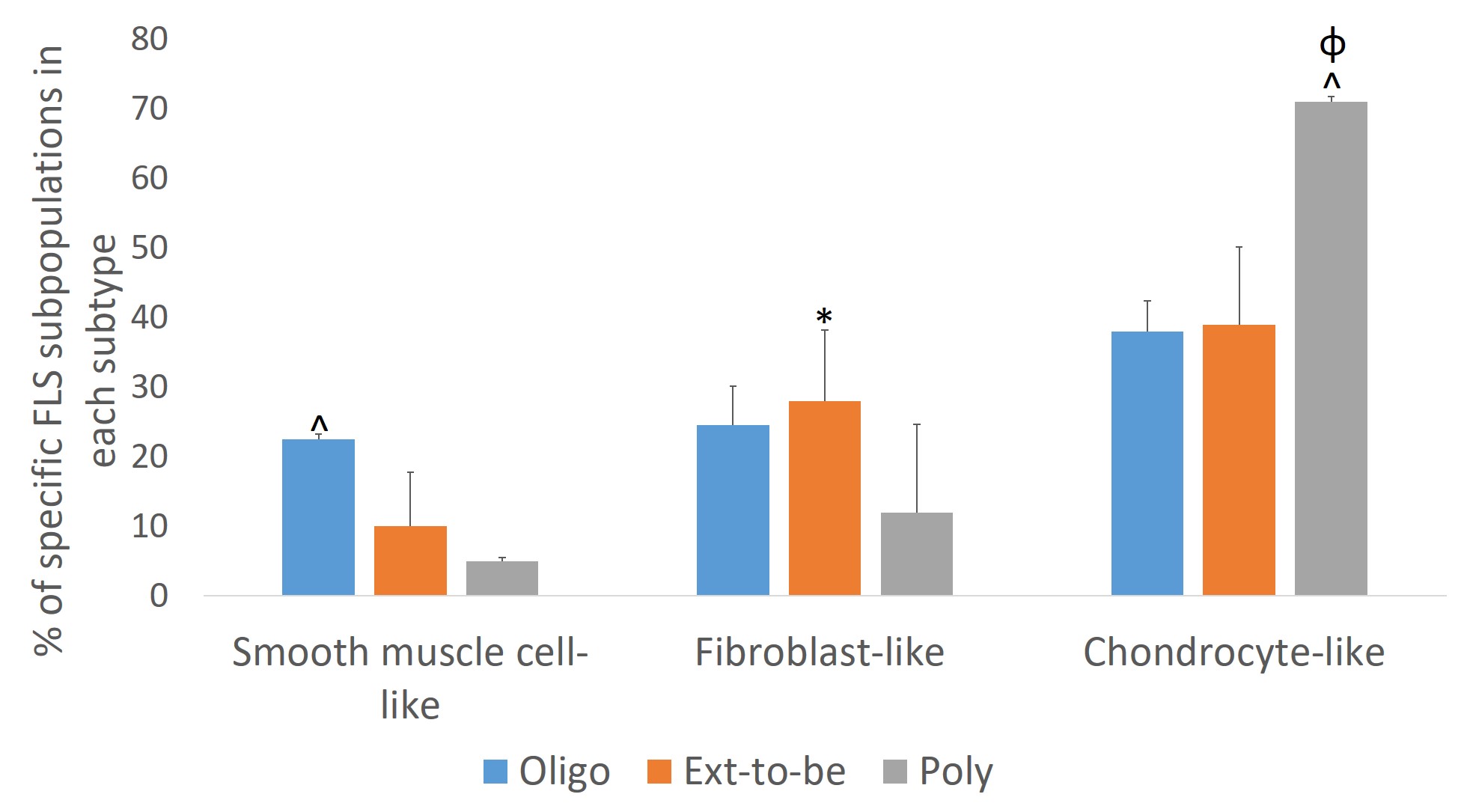Session Information
Date: Tuesday, November 9, 2021
Title: Abstracts: Pediatric Rheumatology – Basic Science (1927–1930)
Session Type: Abstract Session
Session Time: 3:30PM-3:45PM
Background/Purpose: Juvenile Idiopathic Arthritis (JIA) induces growth disturbances in affected joints. Fibroblast-like synoviocytes (FLS) play a crucial role in JIA pathogenesis; however, the mechanisms by which they contribute to disease progression is not well described. Previous studies demonstrated that rheumatoid arthritis (RA) FLS are heterogeneous, and subpopulations with transformed, aggressive phenotypes cause invasive and destructive disease activity (1). Here, we employ single-cell RNA sequencing (scRNA-seq) to investigate JIA FLS heterogeneity and its’ influence on disease extension.
Methods: JIA FLS cell lines from oligoarticular (oligo), extended-to-be (ETB), and polyarticular (poly) types were cultured. scRNA-seq was performed by Genewiz according to 10x Genomics Chromium protocols. Cell ranger software aggregated data from each patient to compare single-cell gene expressions within each JIA type. SeuratR package was used for QC, analysis, and exploration of data.
Results: Using t-Distributed Stochastic Neighbor Embedding (t-SNE), distinct clusters within each JIA FLS type illustrated heterogeneity (Figure 1A). Cells with similar expression patterns cluster together as indicated by a single color. Clusters in close proximity have similar gene expression profiles. Seurat performed Uniform Manifold Approximation and Projection (UMAP) dimensionality reduction, and the clusters co-localized. Majority of clusters within each type co-localize with greater distance between clusters within ETB and poly (Figure 1B). Cells were annotated based on similarity to a reference dataset of cells with known labels (Human Primary Cell Atlas Data) using SingleR data package. Subpopulation percentages were calculated from cell counts (Figure 2). Smooth muscle cell-like cells decreased in more severe JIA types (p< 0.05 in oligo v poly). Fibroblast-like cell percentage was higher in ETB than oligo (p< 0.05). Chondrocyte-like cells percentage increased in poly compared to oligo and ETB (p< 0.05). Differentially expressed genes were revealed within cell-type subpopulations between subtypes of JIA (Table 1). Specifically, ETB downregulate COL1A1 and ACAN and upregulate IFI27 and SERPINE1 in FLS-like cells when compared to oligo (p< 0.00). COL3A1 and VCAM were upregulated in chondrocyte-like cells in ETB when compared to oligo (p< 0.00).
Conclusion: Heterogeneity of FLS from JIA patients could present a novel JIA diagnostic tool. While single cells still co-localize by UMAP, known cell types were identified including: smooth muscle cell-like, fibroblast-like, and chondrocyte-like subpopulations. Differences in subpopulations composition in conjunction with differentially expressed genes within a subpopulation can contribute to distinguishing between subtypes of JIA. Specifically, predicting whether a patient will extend will allow clinicians to better determine therapeutic intervention.
1. Mizoguchi F, Slowikowski K, Wei K, Marshall JL, Rao DA, Chang SK, et al. Functionally distinct disease-associated fibroblast subsets in rheumatoid arthritis. Nature Communications. 2018;9(1):789.
 t-SNE (A) and UMAP (B) of FLS from patients with oligoarticular JIA who stayed persistent course (top row) or went on to an extended course (ETB, middle row) or with polyarticular JIA.
t-SNE (A) and UMAP (B) of FLS from patients with oligoarticular JIA who stayed persistent course (top row) or went on to an extended course (ETB, middle row) or with polyarticular JIA.
 Percentage of FLS subpopulations in cultured FLS from patients with oligoarticular (Oligo), ETB, and polyarticular (Poly) JIA. Smooth muscle-like cells decrease in more severe subtypes of JIA. Percentage of fibroblast-like cells significantly increases in ETB compared to Oligo.
Percentage of FLS subpopulations in cultured FLS from patients with oligoarticular (Oligo), ETB, and polyarticular (Poly) JIA. Smooth muscle-like cells decrease in more severe subtypes of JIA. Percentage of fibroblast-like cells significantly increases in ETB compared to Oligo.
 Seurat single analysis identified the top features or genes of each projected cell type for each subtype. The dot plot shows the average expression of each feature in each cell type and the percent of cells that express that feature.
Seurat single analysis identified the top features or genes of each projected cell type for each subtype. The dot plot shows the average expression of each feature in each cell type and the percent of cells that express that feature.
To cite this abstract in AMA style:
Simonds M, Sullivan K, Rose C, Brescia A. Heterogeneity of Juvenile Idiopathic Arthritis Synovial Fibroblasts Correlates to Disease Progression and Provides Compelling Diagnostic Data [abstract]. Arthritis Rheumatol. 2021; 73 (suppl 9). https://acrabstracts.org/abstract/heterogeneity-of-juvenile-idiopathic-arthritis-synovial-fibroblasts-correlates-to-disease-progression-and-provides-compelling-diagnostic-data/. Accessed .« Back to ACR Convergence 2021
ACR Meeting Abstracts - https://acrabstracts.org/abstract/heterogeneity-of-juvenile-idiopathic-arthritis-synovial-fibroblasts-correlates-to-disease-progression-and-provides-compelling-diagnostic-data/
